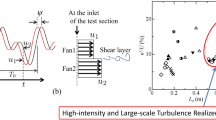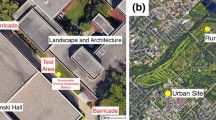Abstract
This study leverages a multi-fan flow control instrument and a mechanized roughness element grid to simulate large- and small-scale turbulent features of atmospheric flows in a large boundary layer wind tunnel (BLWT). The flow control instrument termed the flow field modulator (FFM), is a computer-controlled 3 m \(\times\) 6 m (2D) fan array located at the University of Florida (UF) Natural Hazard Engineering Research Infrastructure (NHERI) Experimental Facility. The system comprises 319 modular hexagonal aluminum cells, each equipped with shrouded three-blade corotating propellers. The FFM enables the active generation of large-scale turbulent structures by replicating user-specified velocity time signals to inject low-frequency fluctuations into BLWT flows. In the present work, the FFM operated in conjunction with a mechanized roughness element grid, called the Terraformer, located downstream of the FFM array. The Terraformer aided in the production of near-wall turbulent mixing through precise adjustment of roughness element heights. A series of BLWT velocity profile measurements were carried out at the UF BLWT test section for a range of turbulence intensity and integral length scale regimes. Input commands to the FFM and Terraformer were iteratively updated via a governing convergence algorithm (GCA) to achieve user-specified mean and turbulent flow statistics. Results demonstrate the capabilities of the FFM for significantly increasing the longitudinal integral length scales compared to conventional BLWT approaches (i.e., no active large-scale turbulence generation). The study also highlights the efficacy of the GCA scheme for attaining prescribed target mean and turbulent flow conditions at the measurement location.
Graphical abstract
















Similar content being viewed by others
Availability of data and materials
The curated dataset of flow velocity time series and relevant metadata is publicly available and can be accessed in the DesignSafe-CI Data Depot repository (see Mokhtar et al. 2023).
References
ASCE 7-22 (2022) Minimum design loads for buildings and other structures American Society of Civil Engineers Reston, VA
Azzam A, Lavoie P (2023) Unsteady flow generation in a wind tunnel using an active grid. Exp Fluids 64(2):29
Barlow JB, Rae WH, Pope A (1999) Low-speed wind tunnel testing. Wiley, New York.
Bendat JS, Piersol AG (2011) Random data: analysis and measurement procedures. John Wiley & Sons
Bienkiewicz B, Cermak JE, Peterka JA, Scanlan RH (1983) Active modeling of large-scale turbulence. J Wind Eng Ind Aerodyn 13(1–3):465–475
Cao S, Nishi A, Kikugawa H, Matsuda Y (2002) Reproduction of wind velocity history in a multiple fan wind tunnel. J Wind Eng Ind Aerodyn 90(12–15):1719–1729
Catarelli RA, Fernández-Cabán PL, Masters FJ, Bridge JA, Gurley KR, Matyas CJ (2020a) Automated terrain generation for precise atmospheric boundary layer simulation in the wind tunnel. J Wind Eng Ind Aerodyn 207:104276
Catarelli RA, Fernández-Cabán PL, Phillips BM, Bridge JA, Masters FJ, Gurley KR, Prevatt DO (2020b) Automation and new capabilities in the university of Florida NHERI boundary layer wind tunnel. Front Built Environ 6:558151
Cook NJ (1978) Wind-tunnel simulation of the adiabatic atmospheric boundary layer by roughness, barrier and mixing-device methods. J Wind Eng Ind Aerodyn 3(2–3):157–176
Fernández-Cabán PL, Masters FJ (2017) Near surface wind longitudinal velocity positively skews with increasing aerodynamic roughness length. J Wind Eng Ind Aerodyn 169:94–105
Foken T, Nappo CJ (2008) Micrometeorology. Springer, Cham
Gan Chowdhury A, Zisis I, Irwin P, Bitsuamlak G, Pinelli JP, Hajra B, Moravej M (2017) Large-scale experimentation using the 12-fan wall of wind to assess and mitigate hurricane wind and rain impacts on buildings and infrastructure systems. J Struct Eng 143(7):04017053
Garcia CM, Jackson PR, Garcia MH (2006) Confidence intervals in the determination of turbulence parameters. Exp Fluids 40:514–522
Gartshore IS (1984) Some effects of upstream turbulence on the unsteady lift forces imposed on prismatic two-dimensional bodies. J Fluids Eng 106(4):418–424
Gramespacher C, Albiez H, Stripf M, Bauer HJ (2019) The generation of grid turbulence with continuously adjustable intensity and length scales. Exp Fluids 60:1–15
Hideharu M (1991) Realization of a large-scale turbulence field in a small wind tunnel. Fluid Dyn Res 8(1–4):53
Hillier R, Cherry NJ (1981) The effects of stream turbulence on separation bubbles. J Wind Eng Ind Aerodyn 8(1–2):49–58
Irwin PA (2008) Bluff body aerodynamics in wind engineering. J Wind Eng Ind Aerodyn 96(6–7):701–712
Katul G, Poggi D, Cava D, Finnigan J (2006) The relative importance of ejections and sweeps to momentum transfer in the atmospheric boundary layer. Bound-Layer Meteorol 120:367–375
Knebel P, Kittel A, Peinke J (2011) Atmospheric wind field conditions generated by active grids. Exp Fluids 51:471–481
Kobayashi H, Hatanaka A (1992) Active generation of wind gust in a two-dimensional wind tunnel. J Wind Eng Ind Aerodyn 42(1–3):959–970
Kobayashi H, Hatanaka A, Ueda T (1994) Active simulation of time histories of strong wind gust in a wind tunnel. J Wind Eng Ind Aerodyn 53(3):315–330
Larssen JV, Devenport WJ (2011) On the generation of large-scale homogeneous turbulence. Exp Fluids 50:1207–1223
Levitan ML, Mehta KC (1992a) Texas Tech field experiments for wind loads part 1: building and pressure measuring system. J Wind Eng Ind Aerodyn 43(1–3):1565–1576
Levitan ML, Mehta KC (1992b) Texas Tech field experiments for wind loads part II: meteorological instrumentation and terrain parameters. J Wind Eng Ind Aerodyn 43(1–3):1577–1588
Lu SS, Willmarth WW (1973) Measurements of the structure of the Reynolds stress in a turbulent boundary layer. J Fluid Mech 60(03):481–511
Melbourne WH (1979) Turbulence effects on maximum surface pressures, a mechanism and possibility of reduction. In: Proceedings of 5th International conference on Wind Engineering, Colorado, USA. Pergamon Press, Oxford, pp 541–552.
Mokhtar N, Fernández-Cabán P, Catarelli R (2023) Generation of large-scale gust structures in a large boundary layer wind tunnel: 3D flow measurement experiments. In: Physical simulation of terrain-induced and large-scale turbulence effects on the effectiveness of wind mitigation strategies for low-rise buildings. DesignSafe-CI. https://doi.org/10.17603/ds2-0m8r-my92v1
Mooneghi MA, Irwin P, Chowdhury AG (2016) Partial turbulence simulation method for predicting peak wind loads on small structures and building appurtenances. J Wind Eng Ind Aerodyn 157:47–62
Morrison MJ, Kopp GA (2018) Effects of turbulence intensity and scale on surface pressure fluctuations on the roof of a low-rise building in the atmospheric boundary layer. J Wind Eng Ind Aerodyn 183:140–151
Neuhaus L, Berger F, Peinke J, Hölling M (2021) Exploring the capabilities of active grids. Exp Fluids 62(6):130
Nishi A, Miyagi H (1995) Computer-controlled wind tunnel for wind-engineering applications. J Wind Eng Ind Aerodyn 54:493–504
Nishi A, Miyagi H, Higuchi K (1993) A computer-controlled wind tunnel. J Wind Eng Ind Aerodyn 46:837–846
Nishi A, Kikugawa H, Matsuda Y, Tashiro D (1997) Turbulence control in multiple-fan wind tunnels. J Wind Eng Ind Aerodyn 67:861–872
Nishi A, Kikugawa H, Matsuda Y, Tashiro D (1999) Active control of turbulence for an atmospheric boundary layer model in a wind tunnel. J Wind Eng Ind Aerodyn 83(1–3):409–419
Ozono S, Ikeda H (2018) Realization of both high-intensity and large-scale turbulence using a multi-fan wind tunnel. Exp Fluids 59:1–12
Ozono S, Nishi A, Miyagi H (2006) Turbulence generated by a wind tunnel of multi-fan type in uniformly active and quasi-grid modes. J Wind Eng Ind Aerodyn 94(4):225–240
Pinyochotiwong (2022) Advancing the active flow control of boundary layer wind tunnels. Dissertation, University of Florida.
Politis DN, White H (2004) Automatic block-length selection for the dependent bootstrap. Economet Rev 23(1):53–70
Rathje EM, Dawson C, Padgett JE, Pinelli JP, Stanzione D, Adair A, Arduino P, Brandenberg SJ, Mosqueda G (2017) DesignSafe: new cyberinfrastructure for natural hazards engineering. Nat Haz Rev 18(3):06017001.
Raupach MR (1981) Conditional statistics of Reynolds stress in rough-wall and smooth-wall turbulent boundary layers. J Fluid Mech 108:363–382
Saathoff PJ, Melbourne WH (1997) Effects of free-stream turbulence on surface pressure fluctuations in a separation bubble. J Fluid Mech 337:1–24
Shaw RH, Pereira AR (1982) Aerodynamic roughness of a plant canopy: a numerical experiment. Agric Meteorol 26(1):51–65
Shig L, Babin V, Shnapp R, Fattal E, Liberzon A, Bohbot-Raviv Y (2023) Quadrant analysis of the Reynolds shear stress in a two-height cnopy. Flow Turbulence Combust, pp 1–23.
Shuyang C, Nishi A, Hirano K, Ozono S, Miyagi H, Kikugawa H, Matsuda Y, Wakasugi Y (2001) An actively controlled wind tunnel and its application to the reproduction of the atmospheric boundary layer. Bound-Layer Meteorol 101:61–76
Simiu E, Yeo D (2019) Wind effects on structures: Modern structural design for wind. Wiley, New York.
Standohar-Alfano CD, Estes H, Johnston T, Morrison MJ, Brown-Giammanco TM (2017) Reducing losses from wind-related natural perils: research at the IBHS research center. Front Built Environ 3:9
Tieleman HW (2003) Wind tunnel simulation of wind loading on low-rise structures: a review. J Wind Eng Ind Aerodyn 91(12–15):1627–1649
Von Karman T (1948) Progress in the statistical theory of turbulence. Proc Natl Acad Sci 34(11):530–539
Zhu W, van Hout R, Katz J (2007) On the flow structure and turbulence during sweep and ejection events in a wind-tunnel model canopy. Boundary-Layer Meteorol 124:205–233
Acknowledgements
The authors would like to acknowledge the DesignSafe-CI web-based research platform for the storage and curation of experimental data (Rathje et al. 2017). The authors also wish to recognize the Powell Structures and Materials Laboratory staff, with special thanks to Scott Powell, Tai-An Chen, Ian Van Voris, Justin Davis, and Rudy Wilder for their contribution in wind tunnel testing and assisting in the development of MATLAB and LabVIEW code for data acquisition and analysis.
Funding
This work is supported by the US National Science Foundation (NSF) under Grant No. 2317176. The authors also acknowledge the NSF NHERI EF awardees under Grant No. 2037725. Any opinions, findings, and conclusions or recommendations expressed in this material are those of the authors and do not necessarily reflect the views of NSF.
Author information
Authors and Affiliations
Contributions
NM and PFC wrote the main manuscript text, NM prepared Figs. 5, 6, 7, 8, 9, and 10, and PFC created the remaining figures (including the graphical abstract). RC developed the BLWT control algorithms and a portion of the data processing and analysis scripts. All authors reviewed the manuscript.
Corresponding author
Ethics declarations
Conflict of interest
The authors declare that they have no known competing interests that could have appeared to influence the work reported in this paper.
Additional information
Publisher's Note
Springer Nature remains neutral with regard to jurisdictional claims in published maps and institutional affiliations.
Rights and permissions
Springer Nature or its licensor (e.g. a society or other partner) holds exclusive rights to this article under a publishing agreement with the author(s) or other rightsholder(s); author self-archiving of the accepted manuscript version of this article is solely governed by the terms of such publishing agreement and applicable law.
About this article
Cite this article
Mokhtar, N.O., Fernández-Cabán, P.L. & Catarelli, R.A. Automated large-scale and terrain-induced turbulence modulation of atmospheric surface layer flows in a large wind tunnel. Exp Fluids 65, 5 (2024). https://doi.org/10.1007/s00348-023-03739-z
Received:
Revised:
Accepted:
Published:
DOI: https://doi.org/10.1007/s00348-023-03739-z




